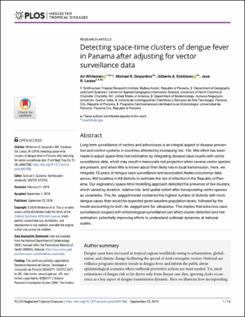Mostrar el registro sencillo del ítem
Detecting space-time clusters of dengue fever in Panama after adjusting for vector surveillance data
| dc.contributor.author | Whiteman, Ari | |
| dc.contributor.author | Desjardins, Michael R. | |
| dc.contributor.author | Eskildsen, Gilberto A. | |
| dc.contributor.author | Loaiza, Jose R. | |
| dc.date.accessioned | 2020-06-30T06:13:00Z | |
| dc.date.available | 2020-06-30T06:13:00Z | |
| dc.date.issued | 2019-09-23 | |
| dc.identifier.other | https://doi.org/10.1371/journal.pntd.0007266 | |
| dc.identifier.uri | http://repositorio-indicasat.org.pa/handle/123456789/143 | |
| dc.description | Long term surveillance of vectors and arboviruses is an integral aspect of disease prevention and control systems in countries affected by increasing risk. Yet, little effort has been made to adjust space-time risk estimation by integrating disease case counts with vector surveillance data, which may result in inaccurate risk projection when several vector species are present, and when little is known about their likely role in local transmission. Here, we integrate 13 years of dengue case surveillance and associated Aedes occurrence data across 462 localities in 63 districts to estimate the risk of infection in the Republic of Panama. Our exploratory space-time modelling approach detected the presence of five clusters, which varied by duration, relative risk, and spatial extent after incorporating vector species as covariates. The Ae. aegypti model contained the highest number of districts with more dengue cases than would be expected given baseline population levels, followed by the model accounting for both Ae. aegypti and Ae. albopictus. This implies that arbovirus case surveillance coupled with entomological surveillance can affect cluster detection and risk estimation, potentially improving efforts to understand outbreak dynamics at national scales. | en_US |
| dc.description.abstract | Long term surveillance of vectors and arboviruses is an integral aspect of disease prevention and control systems in countries affected by increasing risk. Yet, little effort has been made to adjust space-time risk estimation by integrating disease case counts with vector surveillance data, which may result in inaccurate risk projection when several vector species are present, and when little is known about their likely role in local transmission. Here, we integrate 13 years of dengue case surveillance and associated Aedes occurrence data across 462 localities in 63 districts to estimate the risk of infection in the Republic of Panama. Our exploratory space-time modelling approach detected the presence of five clusters, which varied by duration, relative risk, and spatial extent after incorporating vector species as covariates. The Ae. aegypti model contained the highest number of districts with more dengue cases than would be expected given baseline population levels, followed by the model accounting for both Ae. aegypti and Ae. albopictus. This implies that arbovirus case surveillance coupled with entomological surveillance can affect cluster detection and risk estimation, potentially improving efforts to understand outbreak dynamics at national scales. | en_US |
| dc.language.iso | eng | en_US |
| dc.rights | https://creativecommons.org/licenses/by/4.0/ | |
| dc.rights | info:eu-repo/semantics/openAccess | |
| dc.subject | clusters | en_US |
| dc.subject | dengue | en_US |
| dc.subject | Panama | en_US |
| dc.subject | vector surveillance data | en_US |
| dc.title | Detecting space-time clusters of dengue fever in Panama after adjusting for vector surveillance data | en_US |
| dc.type | info:eu-repo/semantics/article | en_US |
| dc.type | info:eu-repo/semantics/publishedVersion |

